| Columns Retired Columns & Blogs |
YBA Design WD202 D/A headphone amplifier Measurements
Sidebar 3: Measurements
I examined the measured behavior of the YBA Design WD202 using the Audio Precision SYS2722 system (see www.ap.com and "As We See It" in the January 2008 issue), as well as, for some tests, my Audio Precision System One Dual Domain and the Miller Jitter Analyzer. I mainly drove the YBA with the SYS2722's AES/EBU output; I also used the USB 2.0 output of my Intel MacBook running OS10.4.11 for the testing, playing back WAV files using Bias Peak 6.2. Examining the WD202's USB properties with the USB Prober program for the Mac identified the device as "USB Audio DAC . . . Burr-Brown from TI," and revealed that while the YBA's USB input would handle sample rates up to 48kHz in adaptive, isochronous mode, it was limited to 16-bit data via this input.
The WD202 successfully locked to AES/EBU datastreams with sample rates ranging from 32 to 96kHz, but I couldn't get it to accept 192kHz data. All of its outputs preserved absolute polarity (ie, were non-inverting), with the balanced XLRs wired with pin 2 hot. The maximum level (at 1kHz) from the YBA's line outputs was to specification, at 2.02V RMS unbalanced and 4.05V balanced. A maximum of 5.23V was available from the headphone output. As set up for review, the YBA's volume control affected only the headphone output; with this control set to its maximum, the headphone output clipped with a signal below 0dBFS. The output impedance from the unbalanced outputs was a low 100 ohms across the audioband, doubling as expected from the balanced jacks. The headphone jack also offered an output impedance of 100 ohms at high and middle frequencies, rising to 161 ohms at 20Hz. This is on the high side for a headphone amplifier; with low-impedance 'phones like the Grados, the lows might sound a little lean and there will be some modification of the frequency response, depending on the headphones' impedance characteristic.
All the remaining tests were performed using the WD202's balanced outputs. The traces in fig.1 show the WD202's frequency response with sample rates of 32, 44.1, and 96kHz. In each case, the response follows the same profile: flat in the audioband, but with a slight (+0.25dB) boost in the top octave interrupted by a sharp cutoff just below half the sample rate. Note the excellent channel matching in this graph. Channel separation (fig.2) was superb, at >125dB in both directions below 1kHz, and still 112dB at 20kHz.
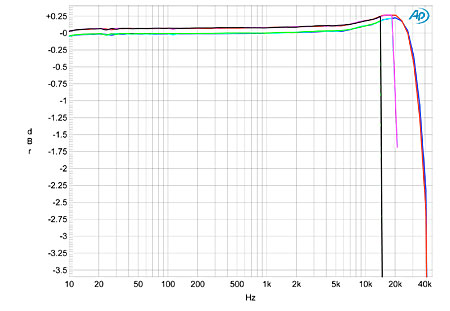
Fig.1 YBA Design WD202, balanced frequency response at –12dBFS into 100k ohms with data sampled at 32kHz (left channel green, right gray), 44.1kHz data (left blue, right red), and 96kHz (left cyan, right magenta). (0.25dB/vertical div.)
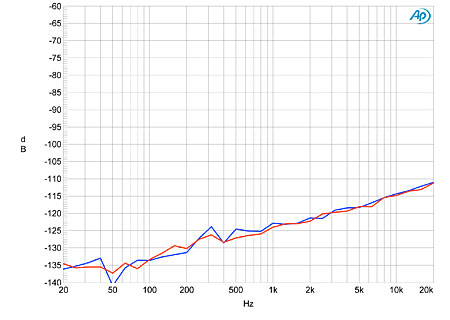
Fig.2 YBA Design WD202, channel separation.
For consistency with my library of digital test reports, I first examine a product's resolution by sweeping the center frequency of a 1/3-octave bandpass filter from 20kHz to 20Hz while the DAC reconstructs a dithered 1kHz tone at –90dBFS with 16- and 24-bit data. The top pair of traces in fig.3 show the spectral analysis for 16-bit data: the traces peak at exactly –90dBFS and are dominated by the dither noise used to encode the signal. Increasing the word length to 24 bits (middle traces) drops the noise floor by almost 20dB, implying a DAC resolution of at least 19 bits. This is superb performance for a relatively affordable D/A processor—15 years ago, you would have had to spend around $10,000 for similar resolution—and the YBA readily decodes a 24-bit tone at –120dBFS (bottom traces), though with a slightly negative linearity error. Fig.4 repeats the analysis using a more rigorous FFT technique. Again, with 16-bit data (cyan and magenta traces), all that is shown is the dither noise, but now with 24-bit data (blue and red traces), even though the noise floor again drops by around 19dB, some discrete tones to either side of the 1kHz fundamental have been unmasked. However, as these are all below –130dBFS, they will be subjectively inconsequential.
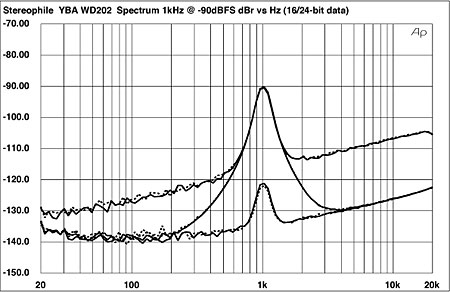
Fig.3 YBA Design WD202, 1/3-octave spectrum with noise and spuriae of dithered 1kHz tone at –90dBFS with 16-bit data (top) and 24-bit data (middle at 2kHz); and of dithered 1kHz tone at –120dBFS with 24-bit data (bottom at 1kHz). (Right channel dashed.)
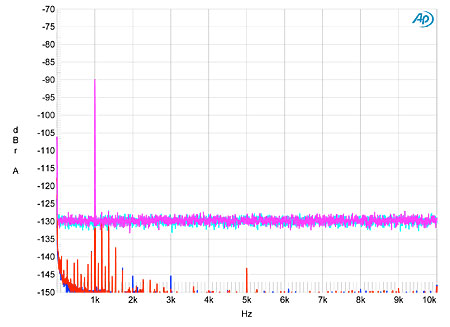
Fig.4 YBA Design WD202, FFT-derived spectrum with noise and spuriae of dithered 1kHz tone at –90dBFS with 16-bit data (left channel cyan, right magenta) and 24-bit data (left blue, right red).
With 16-bit data, any linearity error is negligible down to –110dBFS (fig.5), and the WD202's reproduction of an undithered 16-bit tone at exactly –90.31dBFS is flawless, with excellent waveform symmetry, and the three DC voltage levels that comprise the signal readily resolved (fig.6). The DAC's self-noise is sufficiently low that the symmetrical Gibbs Phenomenon "ringing" on the waveform tops and bottoms can be clearly seen, suggesting that the WD202 uses a conventional FIR reconstruction filter. With undithered 24-bit data, the YBA offers a superbly well-defined sinewave (fig.7).
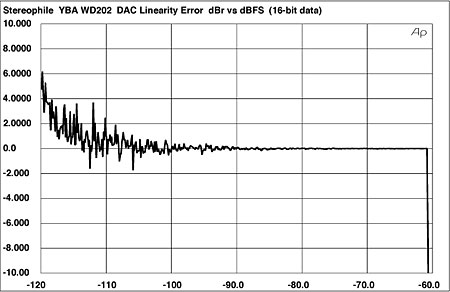
Fig.5 YBA Design WD202, left-channel linearity error, 16-bit data (2dB/vertical div.).
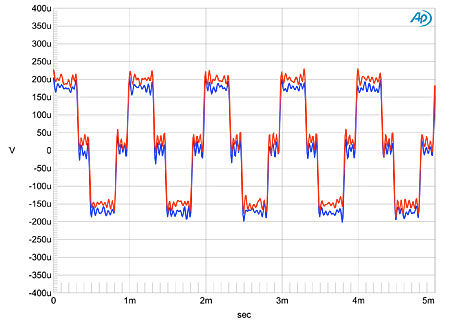
Fig.6 YBA Design WD202, waveform of undithered 1kHz sinewave at –90.31dBFS, 16-bit data (left channel blue, right red).
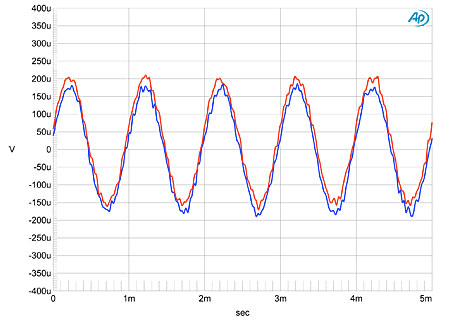
Fig.7 YBA Design WD202, waveform of undithered 1kHz sinewave at –90.31dBFS, 24-bit data (left channel blue, right red).
The WD202 offers very low levels of distortion, primarily the subjectively benign second and third harmonic, though the fact that it is also very quiet unmasks a regular series of higher-order harmonics (fig.8). But as these are all well below –110dBFS, they will be inconsequential. This spectrum was taken into the high lab load impedance; commendably, the distortion didn't rise into the punishing 600-ohm load. The WD202 also offers very low levels of intermodulation distortion, the second-order difference component at 1kHz (arising from a mix of 19 and 20kHz tones, each at –6dBFS, into 100k ohms) just reaching –100dBFS (0.001%), and all higher-order components lying at or below –110dBFS (0.0003%, fig.9). Into 600 ohms, the level of the spurious 1kHz tone didn't change, but the spuriae at 18 and 21kHz rose to a still negligible –94dBFS (0.002%, fig.10).
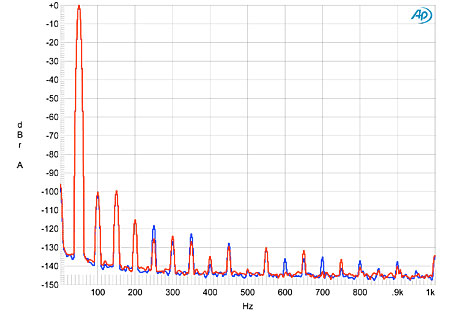
Fig.8 YBA Design WD202, spectrum of 50Hz sinewave at 0dBFS into 100k ohms, 24-bit data (left channel blue, right red; linear frequency scale).

Fig.9 YBA Design WD202 HF intermodulation spectrum, 19+20kHz at 0dBFS peak into 100k ohms, 24-bit data (left channel blue, right red; linear frequency scale).

Fig.10 YBA Design WD202 HF intermodulation spectrum, 19+20kHz at 0dBFS peak into 600 ohms, 24-bit data (left channel blue, right red; linear frequency scale).
Finally, testing the WD202's S/PDIF for its rejection of jitter, using the Miller Audio Research Analyzer and my worst-case source of a PC playing a 16-bit J-Test tone via 15' of plastic TosLink cable, gave 455 picoseconds peak–peak of jitter-related spuriae in its analog output. This mainly comprised data-related sidebands at ±229Hz, and is low in absolute terms. The central peak representing the Fs/4 tone was narrow and well defined (not shown). Via the USB input, all the sidebands disappeared, which is commendable; but analyzed with the Audio Precision SYS2722, the central peak broadened (fig.11) due to the presence of random low-frequency variations in the sample frequency.
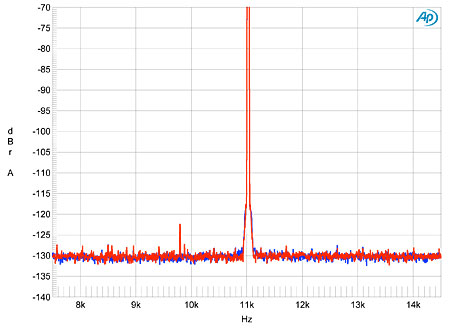
Fig.11 YBA Design WD202 high-resolution jitter spectrum of analog output signal, 11.025kHz at –6dBFS, sampled at 44.1kHz with LSB toggled at 229Hz, 16-bit data via USB. Center frequency of trace, 11.025kHz; frequency range, ±3.5kHz (left channel blue, right red).
Despite its relatively low price, YBA Design's WD202 offers excellent digital audio engineering. Its only failing is its inability handle high-resolution data via its USB input, but that can be addressed with one of the inexpensive USB-S/PDIF converters from Stello or Bel Canto that I reviewed in the May issue.—John Atkinson
- Log in or register to post comments




































